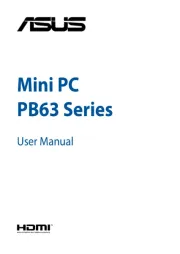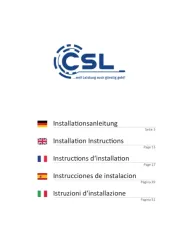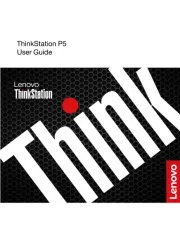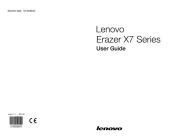Asus Vivo PC X M80CJ Oculus Bedienungsanleitung PDF
Laden Sie hier das Handbuch auf Deutsch für Asus Vivo PC X M80CJ Oculus (46 Seiten) in der Kategorie Desktop herunter. Dieses Handbuch war für 19 Personen nützlich und wurde von 10 Nutzern mit durchschnittlich 4.3 Sternen bewertet. Klicken Sie auf Download, um es herunterzuladen, oder auf Online lesen, um unseren simultanen Leser zu öffnen.
Produktspezifikationen
| Marke: | Asus |
| Kategorie: | Desktop |
| Modell: | Vivo PC X M80CJ Oculus |
| Installiertes Betriebssystem: | Windows 10 Home |
| Prozessorhersteller: | Intel |
| Anzahl Prozessorkerne: | 4 |
| WLAN: | Ja |
| WLAN-Standards: | 802.11a, Wi-Fi 5 (802.11ac), 802.11b, 802.11g, Wi-Fi 4 (802.11n) |
| Bluetooth: | Ja |
| Bluetooth-Version: | 4.1 |
| Breite: | 76 mm |
| Tiefe: | 280 mm |
| Gewicht: | 2200 g |
| AC-Netzadapter: | Ja |
| Produkttyp: | PC |
| Produktfarbe: | Schwarz |
| Höhe: | 260 mm |
| Anzahl USB 2.0 Anschlüsse: | 2 |
| Eingebauter Ethernet-Anschluss: | Ja |
| Anzahl Ethernet-LAN-Anschlüsse (RJ-45): | 1 |
| Anzahl HDMI-Anschlüsse: | 2 |
| Ethernet LAN Datentransferraten: | 10,100,1000 Mbit/s |
| Stromversorgung: | 230 W |
| DVI Anschluss: | Nein |
| Intel® Wireless-Display (Intel® WiDi): | Ja |
| Mikrofon-Eingang: | Nein |
| Kabelsperre-Slot: | Ja |
| Slot-Typ Kabelsperre: | Kensington |
| Prozessor-Taktfrequenz: | 2.5 GHz |
| Prozessorfamilie: | Intel® Core™ i5 |
| Prozessor: | i5-7300HQ |
| Anzahl der installierten Speicherlaufwerke: | 1 |
| RAM-Speicher: | 16 GB |
| USB 3.2 Gen 1 (3.1 Gen 1) Anzahl der Anschlüsse vom Typ A: | 4 |
| Gehäusetyp: | Tower |
| Prozessor-Cache: | 6 MB |
| Prozessor Boost-Frequenz: | 3.5 GHz |
| Konfliktloser-Prozessor: | Ja |
| Prozessor Codename: | Kaby Lake |
| Prozessor Lithografie: | 14 nm |
| Prozessorbetriebsmodi: | 64-Bit |
| Prozessor-Paketgröße: | 42 x 28 mm |
| Prozessor-Threads: | 4 |
| Systembus-Rate: | 8 GT/s |
| Thermal Design Power (TDP): | 45 W |
| Prozessor-Serien: | Intel Core i5-700 Desktop Series |
| ARK Prozessorerkennung: | 97456 |
| Interner Speichertyp: | DDR4-SDRAM |
| Integrierter Kartenleser: | Nein |
| Top WLAN-Standard: | Wi-Fi 5 (802.11ac) |
| Intel® Turbo-Boost-Technologie: | 2.0 |
| Eingebettete Optionen verfügbar: | Nein |
| Intel® 64: | Ja |
| Intel® Virtualization Technologie (VT-X): | Ja |
| Tastatur enthalten: | Ja |
| Speicherkanäle: | Zweikanalig |
| RAM-Speicher maximal: | 16 GB |
| Maus enthalten: | Ja |
| Verkabelungstechnologie: | 10/100/1000Base-T(X) |
| HDD Kapazität: | 1000 GB |
| HDD Größe: | 2.5 Zoll |
| Speichermedien: | HDD+SSD |
| Gesamtspeicherkapazität: | 1512 GB |
| Kombinierter Kopfhörer-/Mikrofon-Anschluss: | Ja |
| Intel® Hyper-Threading-Technik (Intel® HT Technology): | Nein |
| Intel® Identity-Protection-Technologie (Intel® IPT): | Ja |
| Intel® Smart-Response-Technologie: | Ja |
| Verbesserte Intel SpeedStep Technologie: | Ja |
| Anzahl installierter Prozessoren: | 1 |
| PCI-Express-Slots-Version: | 3.0 |
| Tjunction: | 100 °C |
| PCI Express Konfigurationen: | 1x16, 1x8+2x4, 2x8 |
| Maximale Anzahl der PCI-Express-Lanes: | 16 |
| Maximaler interner Speicher, vom Prozessor unterstützt: | 64 GB |
| Speichertypen, vom Prozessor unterstützt: | DDR3L, DDR4-SDRAM, LPDDR3-SDRAM |
| Speichertaktraten, vom Prozessor unterstützt: | 1600,2133,2400 MHz |
| Durch den Prozessor (max) unterstützte Speicherbandbreite: | 34.1 GB/s |
| Prozessorgeneration: | Intel® Core™ i5 der siebten Generation |
| On-Board Grafikadaptermodell: | Intel® HD Graphics 630 |
| Eingebaute Grafikadapter: | Ja |
| Dediziertes Grafikadaptermodell: | NVIDIA® GeForce® GTX 1060 |
| Separater Grafik-Adapterspeicher: | 3 GB |
| Dedizierter Grafikspeicher Typ: | GDDR5 |
| Separater Grafikadapter: | Ja |
| On-Board Grafikadapter Basisfrequenz: | 350 MHz |
| Maximale dynamische Frequenz der On-Board Grafikadapter: | 1000 MHz |
| On-Board Grafikadapter Geräte-ID: | 0x591B |
| Maximaler integrierter Grafik-Adapterspeicher: | 64 GB |
| Anzahl an unterstützen Displays (On-Board-Grafik): | 3 |
| On-Board Grafikadapter DirectX Version: | 12.0 |
| On-Board Grafikadapter OpenGL Version: | 4.4 |
| Speichertaktfrequenz: | 2400 MHz |
| Anzahl der installierten HDDs: | 1 |
| SSD Speicherkapazität: | 512 GB |
| Optisches Laufwerk - Typ: | Nein |
| Anzahl SSD installiert: | 1 |
| SSD Schnittstelle: | SATA |
| Betriebssystemsarchitektur: | 64-Bit |
| Anzahl DisplayPort Anschlüsse: | 1 |
| Anzeige enthalten: | Nein |
| Unterstützte Befehlssätze: | AVX 2.0, SSE4.1, SSE4.2 |
| Intel® Quick-Sync-Video-Technik: | Ja |
| Intel® InTru™ 3D Technologie: | Ja |
| Intel® Clear Video HD Technology für (Intel® CVT HD): | Ja |
| Intel® AES New Instructions (Intel® AES-NI): | Ja |
| Execute Disable Bit: | Ja |
| Leerlauf Zustände: | Ja |
| Thermal-Überwachungstechnologien: | Ja |
| Intel® Trusted-Execution-Technik: | Nein |
| CPU Konfiguration (max): | 1 |
| Intel® VT-x mit Extended Page Tables (EPT): | Ja |
| Intel® TSX-NI: | Nein |
| Intel® Sicherer Schlüssel: | Ja |
| Intel Stable Image Platform Program (SIPP): | Nein |
| Intel® OS Guard: | Ja |
| Intel® Virtualisierungstechnik für direkte I/O (VT-d): | Ja |
| Intel® Clear Video Technologie: | Ja |
| Intel® Software Guard Extensions (Intel® SGX): | Ja |
| Bus Typ: | DMI3 |
| ECC vom Prozessor unterstützt: | Nein |
| HDD Schnittstelle: | SATA |
| Intel® My-WiFi-Technik (Intel® MWT): | Ja |
| Intel® Flex Memory Access: | Ja |
| Intel® Enhanced Halt State: | Ja |
| Intel® Clear Video Technology für Mobile Internet Devices (Intel® CVT for MID): | Ja |
| Intel® Identity Protection Technologieversion: | 1.00 |
| Intel® Secure Key Technologieversion: | 1.00 |
| Intel® TSX-NI-Version: | 0.00 |
| Virtual Realtity (VR) bereit: | Ja |
| Intel® Small Business Advantage (SBA) Version: | 1.00 |
| Intel® Smart Response Technologieversion: | 1.00 |
| Intel® Stable Image Platform Program (SIPP) Version: | 0.00 |
| TDP-down konfigurierbar: | 35 W |
Bedienungsanleitung Desktop Asus

8 August 2025

7 August 2025

5 August 2025

4 August 2025

4 August 2025
Bedienungsanleitung Desktop
Neueste Bedienungsanleitung für -Kategorien-

9 August 2025

9 August 2025

9 August 2025

9 August 2025

9 August 2025